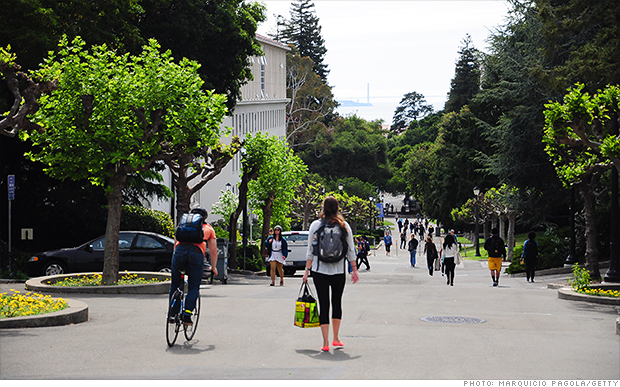 The University of California at Berkeley said it plans to increase the percentage of out-of-state students it accepts to 23% from 20%.
The University of California at Berkeley said it plans to increase the percentage of out-of-state students it accepts to 23% from 20%. NEW YORK (CNNMoney)
The student had a near-perfect grade point average, took the maximum number of advanced placement classes, joined extracurricular clubs and was in the National Honor Society.
But the University of California at Berkeley turned her down.
"I thought, 'Wow, a couple of years ago, she would've gotten in,'" said Barnes, who works at Hanford West, a Central Valley high school.
Barnes and other counselors have seen the public University of California system steadily enroll more out-of-state and international students, while the number of in-state students are declining.
Related: Few to benefit from Obama's student loan program
Coveted for the higher tuition they pay, the number of non-resident students enrolled at the University of California's 10 campuses rose from 23,000 in 2009 to 32,000 in 2012 -- an increase of nearly 33%. Meanwhile, the number of in-state students has fallen 1.3% to 197,000.
After all, resident students paid an average of $8,893 for tuition and fees at public, four-year institutions nationwide this year, while out-of-state students paid $22,203, according to the College Board.
"You're basically auctioning off spaces for people with more money," said Patrick M. Callan, president of the National Center for Public Policy and Higher Education, a California-based think tank. "In-state students have less of a shot at public universities."
After years of state budget cuts, "tuition from out-of-state and international students is crucial," said Berkeley's chancellor Nicholas Dirks in a statement.
In April, Dirks announced that Berkeley would boost enrollment of nonresidents to 23% from 20% over the next three years.
That means next year it will add another 100 out-of-state students, who will bring in $2.2 million more in revenue than in-state students, who are eligible for in-state tuition subsidies, would.
Meanwhile, the number of California residents enrolling at Berkeley will continue to shrink, falling from 3,800 in 2006 to 3,100 in 2013, according to UC figures.
Related: Half of college grads still relying on parents' money
At such large public universities as the University of Virginia, the University of Colorado at Boulder, and the University of Michigan at Ann Arbor, nonresidents make up 30% or more of enrollment, according to the Center for College Affordability and Productivity, a Washington, D.C. think tank.
Colorado law dictates that at least 55% of the student body be composed of residents, said Kevin MacLennan, director of admissions at the University of Colorado at Boulder. Since the law was passed in 1992, the university has been able to offer admission to every qualified resident who applies, he said.
At the University of Michigan, all decisions "are based on the imperative to enroll the best possible incoming class," said spokesman Rick Fitzgerald. He said the percentage of non-resident students has not varied much in the last four years, going from 40.1% to 41.2%.
The University of Virginia did not respond to requests for comment.
MacLennan and Fitzgerald both said the growing percentage of out-of-state students is due in part to the shrinking number of high school graduates in their states.
But money is part of it, too. MacLennan said his university has pushed to increase the proportion of international students among the out-of-state population in the last few years, "for geographic diversity and due to the revenue piece."
Pushback may be looming. "All of these schools have political pressure to make room for domestic students," said Richard Vedder, director at the Center for College Affordability and Productivity and an economist at Ohio University.
Related: Community college grads out-earn bachelor's degree holders
The idea that out-of-state students are taking spots from in-state ones is "more of a perception than a reality," said Daniel Hurley, associate vice president for government relations and state policy at the American Association of State Colleges and Universities.
The only place this may be happening is at "more select, public research universities," where competition for admission is particularly fierce, he said.
University officials say there's also a lack of data to show definitively that one group has been displacing the other.
But research released last year by professors Bradley Curs and Ozan Jaquette of the universities of Missouri and Arizona, respectively, found that increases in the number of nonresident students at flagship public universities led to decreases in the number of low-income and minority students.
Related: College savings gap widens between rich and poor
As nonresident enrollment at Berkeley rose, for instance, the number of black and Hispanic freshmen fell, the research showed. The same thing happened at the University of Illinois at Urbana-Champaign and the University of Wisconsin at Madison.
The study didn't directly address whether all in-state students are being crowded out. But it stands to reason that "public universities with selective admissions and targeted enrollment that are pursuing out-of-state students are doing so at the expense of in-state students," said Curs.
"It's a balancing act," said Anne De Luca, associate vice chancellor for admissions and enrollment at Berkeley. "We strive to preserve access and maintain excellence in the undergraduate experience, and pull a number of levers to make this happen... one of them being non-resident tuition from out-of-state students," she said.
First Published: June 12, 2014: 7:14 AM ET
Anda sedang membaca artikel tentang
In-state students getting squeezed out at public universities
Dengan url
http://bolagaya.blogspot.com/2014/06/in-state-students-getting-squeezed-out.html
Anda boleh menyebar luaskannya atau mengcopy paste-nya
In-state students getting squeezed out at public universities
namun jangan lupa untuk meletakkan link
In-state students getting squeezed out at public universities
sebagai sumbernya
0 komentar:
Posting Komentar